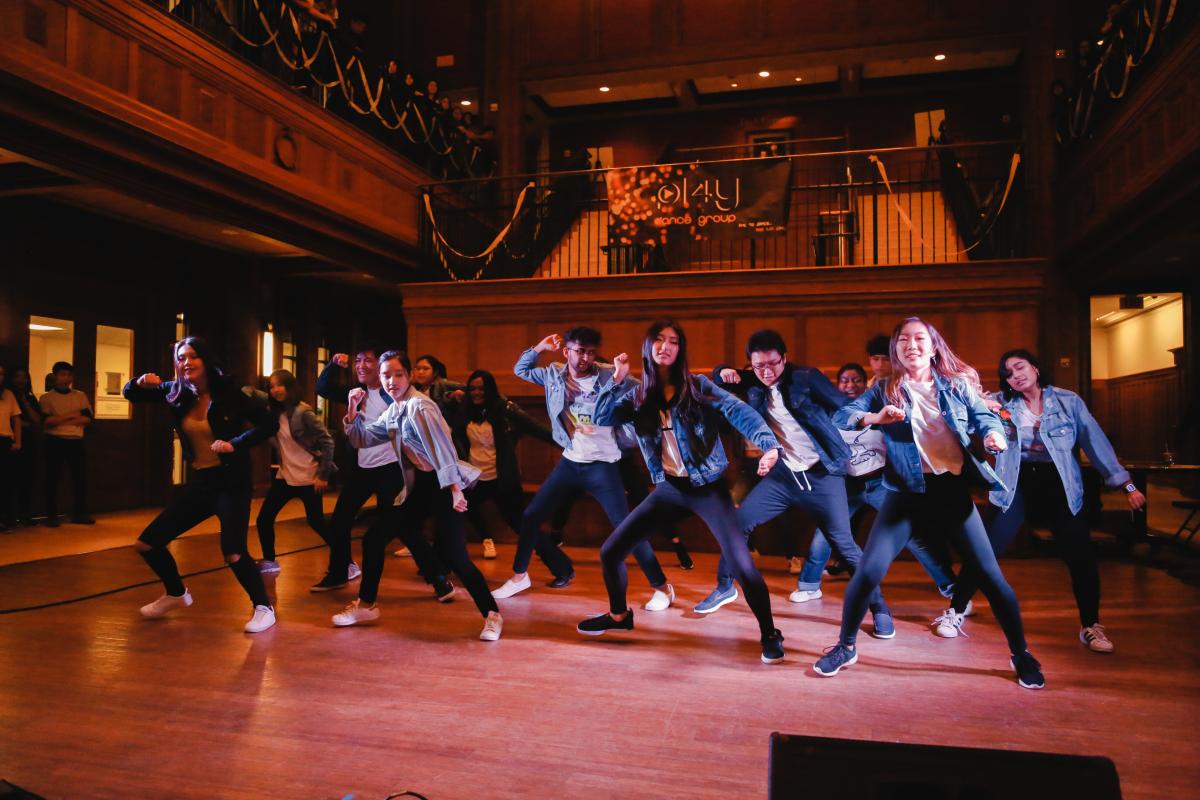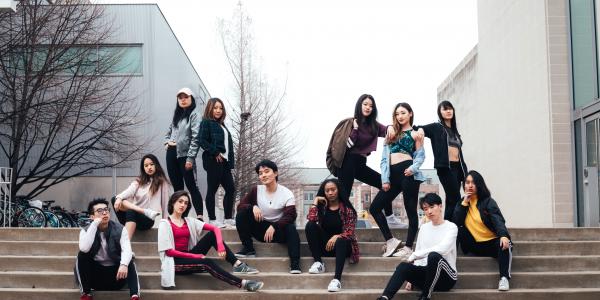K-Pop, a genre of music best known for its intricately choreographed music videos, has inspired “cover” groups throughout the world. For one such group at WashU, the dance movement provides students with a stepping-stone into the field of cultural studies.
In front of Ridgely Hall, four students dressed completely in black lie in a heap on the ground. A camera pans over them, and then music begins to play. One sits up. The rest lift their hands. Slowly, they stand, and begin to dance. These students are from PL4Y, a student organization that recreates some of the popular Korean music videos that have been watched by millions of fans around the world.
PL4Y was founded in 2010 by a small group of friends who were interested in K-pop music and enjoyed covering dances. Word of their covers spread, and today, the student group has grown to almost a hundred members participating in their regular workshops, yearly showcase, and stylized dance videos on YouTube.
Most students who join PL4Y have already been exposed to K-pop music in some form, but for many it is their first time dancing to it. Martha Benduski, a WashU psychology major and former co-president of PL4Y who helped film the above video, had no dance experience whatsoever when she first joined the group as a first-year student, but she quickly fell in love with it. Dancing K-pop has become a huge part of her undergraduate experience, and has even expanded her academic interests by inspiring her to take course on K-pop in East Asian studies.

It might be surprising to think of K-pop as an area of academic inquiry, even in a department that focuses on literature and cultural studies. What do static required readings from the eighteenth century have to do with the catchy lyrics vocalized by flashy K-pop superstars? More than you might think, according to Ivanna Yi, the Korea Foundation postdoctoral fellow in East Asian Studies. In her course “Korean Literature and Performance from P'ansori to K-pop,” she teaches that many older cultural texts can be, and in fact were designed to be, performed.
Yi hopes to inspire students by showing them how the readings she assigns from the Chŏson Dynasty are just as dynamic and performative as modern-day K-pop. To help students see eighteenth-century texts as performance art rather than mere words on a page, the course includes several hands-on performance workshops to give students a chance to actually perform texts through learning to sing the lyric poetry form of sijo and the traditional form of epic storytelling known as p'ansori.
Yi notes the influence that performing texts has on her students, saying, “After our workshops, I find that students begin to think differently about the texts we read. Texts become more accessible as living works of art because the students have somatic knowledge of how they can be performed. Students also tend to read more deeply and look for more layers in a text, paying greater attention to the sonic aspects of poetry and relating the works to their own lives.”
"Texts become more accessible as living works of art because the students have somatic knowledge of how they can be performed."
Another goal of Yi’s course is to show that traditional Korean music, or kugak, is a living tradition that continues today in performances that mix older forms with newer genres like K-pop. For example, she shows students how a video from a K-pop group known as BTS integrates Samgo-mu, a traditional Korean drum dance, into their performance. Yi sees this concert, and other fusion performances, as evidence that artists are deliberately reaching back to the past, keeping traditional forms alive in ways that are constantly evolving.
Roughly half of Yi’s students have Korean heritage and are excited to learn more about their own history and culture. Others have backgrounds in East Asia, but about a fourth have no direct connection to the region and, like Benduski, have come to an interest in Korean traditions through K-pop or other popular exports of the Korean Wave (also known as Hallyu), like dramas.
Benduski is studying abroad this semester and was not able to take Yi’s class, but she did take another course on K-pop last semester with Linling Gao-Miles, a lecturer in international and area studies. In her course, “From McDonald's to K-pop: New Movements in East Asia,” Gao-Miles examines K-pop as a case study of an interesting transcultural movement.
Unlike many similar movements that tend to travel from the West to East, K-pop is an example of a trend that has moved from East to West. This movement across national boundaries is not entirely linear, however. While dealing with K-pop as a scholarly subject, Gao-Miles guides the students to see the broader context that shaped K-pop, such as J-pop and hip hop, as well as K-pop’s reception in various Asian countries and even in the US.
Gao-Miles and her students examine how K-pop has managed to traverse cultural boundaries to become popular across the globe. Benduski recalls learning that many K-pop artists have consciously designed their performances to be both aesthetically engaging and easily copied, which has helped them “go viral” and move across cultural boundaries more fluidly.
Benduski knows from experience that the replicability of K-pop dance videos has encouraged their popularity on the WashU campus. She was one of three coordinators of PL4Y’s “no-audition” dance at the club’s showcase last year, which is specifically designed to be welcoming to students with no prior dance experience. Although a majority of the participants had never performed K-pop before, they quickly became hooked. This is possible largely because the way K-pop has been designed to be easy to copy makes it a perfect entry into dance for beginners.

Many of Gao-Miles’ students enter the course with a strong interest in K-pop, and she says that their enthusiasm contributes specific knowledge of current K-pop trends to the theoretical basis she provides, which she encourages in a group project that examines K-pop and its transnational reception. She notes, “The students are very good at collecting data and detailed information about K-pop music and the most recent developments of K-pop idols, bands, concerts, and fans, but the study in this course equips them with knowledge and analytical frameworks to conceptualize these dynamics.” For example, “K-pop provides a fun case study when it comes to theorizing East Asian notions of masculinity or ‘cuteness.’”
According to Gao-Miles, K-pop is “culturally hybrid and its emergence and popularity must be understood both within and beyond national or regional limits,” and the interdisciplinary program in East Asian Studies at WashU provides an academic base for doing transnational research on trends that cannot be contained within the boundaries of a single discipline or country.
Both Gao-Miles and Yi comment that East Asia is becoming an increasingly large economic player in the world’s economy, and claim that students who have a background in this area of the world will have an advantage in the future.
For students like Benduski, however, the transcultural experience that K-pop has provided her goes beyond any kind of economic or academic advantage. She says of her experience performing K-pop, “I've learned so many invaluable lessons. PL4Y taught me how to build a community. Dance taught me how to critique myself and to work hard in a way that is both physical and mental. Through my role as president I learned about leading a team, event logistics, marketing, design, and even film. K-pop has taught me how to learn about and fall in love with another culture. All of these are things that I will take with me moving forward in my life.”
Lead image by Jiyoon Kang



